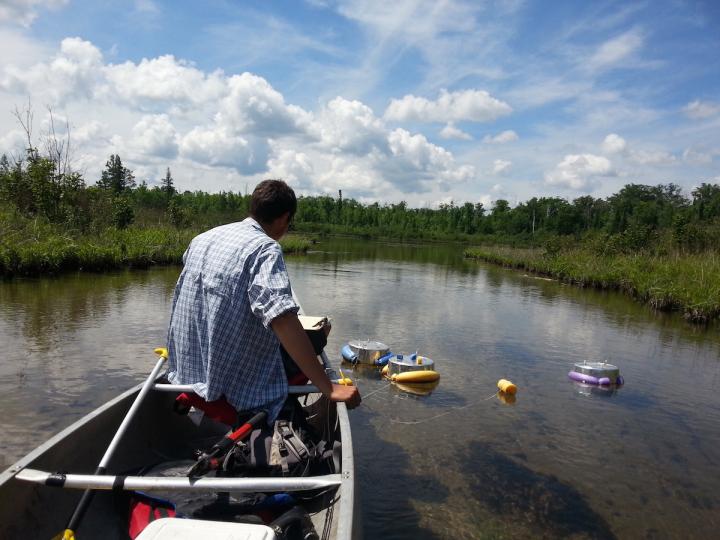Greenhouse gas emissions from freshwater higher than thought

Nick Gubbins, an undergraduate student who has worked in the Stanley lab, takes methane flux measurements in the field. Credit: Luke Loken, UW-Madison Center for Limnology
According to a new analysis in the journal Ecological Monographs, by researchers at the University of Wisconsin-Madison and colleagues, the world's rivers and streams pump about 10 times more methane into our atmosphere than scientists estimated in previous studies. The new study also found that human activity seems to drive which streams are the biggest contributors.
“Scientists know that inland waters, like lakes and reservoirs, are big sources of methane,” says Emily Stanley, a professor at the UW-Madison Center for Limnology and lead author of the paper. Yet accurately measuring emissions of methane from these sources has remained a challenge.
Like carbon dioxide, methane is a greenhouse gas that traps heat at the Earth's surface. It is less prevalent than carbon dioxide in the atmosphere but also more potent: A molecule of methane results in more warming than a molecule of carbon dioxide. Understanding how much methane is emitted into the atmosphere from all sources helps scientists account for the full global greenhouse gas budget, and take measures to mitigate its impact.
Rivers and streams haven't received much attention in accounting for that budget, Stanley says, because they don't take up much surface area on a global scale and, with respect to methane, didn't seem to be all that gassy. But over the years, measurements taken by Stanley and her lab members seemed to indicate these sources may produce more methane than scientists had previously known.
Together with other center researchers and scientists at the University of Winnipeg and the U.S. Geological Survey's LandCarbon Project, the team created a database of measured methane flux (the exchange of the gas between water and atmosphere) and methane concentrations measured in streams and rivers using data from 111 publications and three unpublished datasets.
The research team then used two different methods to calculate the best estimates of global methane emissions from the data. They found the emissions to be an order of magnitude higher than scientists had previously reported.
The result was “very surprising,” Stanley says. “I thought maybe we'd be off by a factor of two, so I was taken aback by how much higher the estimate was.”
The researchers pointed to one possible reason: Not every stream is identical. The analysis revealed noticeably higher methane emissions from streams and rivers in watersheds marked with heavy agriculture, urban development or the presence of dams. This suggests efforts to improve stream health may have the added benefit of reducing greenhouse gases.
“The fact that human activity in a watershed leads to high methane concentrations in those rivers and streams underscores yet another reason to pay attention to water quality,” says Stanley. “On top of everything else, it adds to this climate problem, too.”
Methane from freshwater is often a byproduct of bacterial metabolism, as they break down organic matter under low-oxygen conditions, like in the sediment at the bottom of a lake. As the climate warms, the contribution of greenhouse gases from natural sources likes rivers, streams and wetlands is expected to increase because higher temperatures accelerate this bacterial breakdown, releasing more carbon dioxide and methane.
The next step, says Stanley, is figuring out where all that methane comes from. Running rivers and streams are usually better aerated and full of oxygen, making all that methane a bit of a mystery. Is it coming from groundwater? Somewhere along a riverbank? At the bottom of the stream itself? For now, the babbling brook is keeping that information to itself.
###
Adam Hinterthuer (608) 890-2187, hinterthuer@wisc.edu
Media Contact
All latest news from the category: Earth Sciences
Earth Sciences (also referred to as Geosciences), which deals with basic issues surrounding our planet, plays a vital role in the area of energy and raw materials supply.
Earth Sciences comprises subjects such as geology, geography, geological informatics, paleontology, mineralogy, petrography, crystallography, geophysics, geodesy, glaciology, cartography, photogrammetry, meteorology and seismology, early-warning systems, earthquake research and polar research.
Newest articles

Compact LCOS Microdisplay with Fast CMOS Backplane
…for High-Speed Light Modulation. Researchers from the Fraunhofer Institute for Photonic Microsystems IPMS, in collaboration with HOLOEYE Photonics AG, have developed a compact LCOS microdisplay with high refresh rates that…

New perspectives for material detection
CRC MARIE enters third funding period: A major success for terahertz research: Scientists at the University of Duisburg-Essen and the Ruhr University Bochum have been researching mobile material detection since…

CD Laboratory at TU Graz Researches New Semiconductor Materials
Using energy- and resource-saving methods, a research team at the Institute of Inorganic Chemistry at TU Graz aims to produce high-quality doped silicon layers for the electronics and solar industries….



